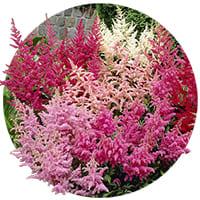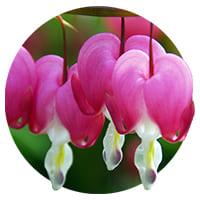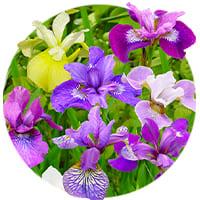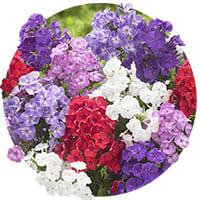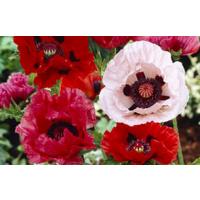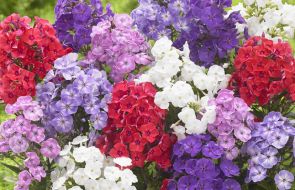
Bare-Root Perennials and Potted Plants
Bare-Root Perennials and Potted Plants
Last Reviews
Perennial Plants and Flowers for Sale Online | Dutch Bulbs
Buy perennial plants and flowers from Dutch Bulbs across our wide range of quality bare root perennials for a stunning rainbow of colors and flower forms.
Perennial Plants Catalog
Dutch Bulb ensures you get plants of your preference through our extensive perennial plants' catalog, so you can have a whole collection of bare root perennials that otherwise would not be able to grow on normal soil where you live. Perennial flowers naturally create an aesthetic appeal to the landscape and as a gardener; you need to set the pace for the surrounding. Almost all of them can grow anywhere but just for your peace of mind and to save your strength, you can plant them in pots.
How to Plant Perennial Flowers in Containers
Gardening in containers is a cost-efficient and reliable way of growing perennial plants and flowers, especially, if you want to expand your palette, planting area or the ground lacks richer soils. With containers, it is possible to plant different combinations of perennial flowers and attend to them when you deem fit without having to spend lots of your time and energy actually doing a whole yard of flowers. Below are ways of going about it.
- Get a clean and big container
The first thing is to choose either a plastic or a clay container. Both have their pros and cons though. Most clay ones are appealing and make the surroundings look wonderful but heavy as hell, especially the painted ones. On the other hand, plastic ones are light, portable, and retain moisture the most. Go for larger pots as perennial flowers have larger roots and hence require a spacious setting to thrive well. - Drainage hole
Drainage is a crucial part of any planting activity. For perennials, it is important to drill holes in your containers before you start the process, just do it in a way that the soil doesn’t fall off. - Choose less potting soil
When filling up your container, avoid using just any ground soil. Rather use lighter and high-quality potting soil that already has fertilizer, or you could mix it yourself. Test the soil for alkaline and acid levels to know exactly where each of the perennial tubers will do best, plus its moisture and dryness. Before planting, the flowers do your research and find out what type of soil your bulb will do better.
Which Perennial Flowering Plants Survive in Winter?
In winter, everyone wants to cozy up in warm places or probably wrap themselves up in layers of clothing. Yet that is not the case for most of our beautiful flowers. Surprisingly, some of them do not die and can continue doing well either on the open ground or under container care. Some of these perennial flowering plants include Peonies, Coral Bells, Sedum, Wild Columbine, Bee Balm, Coneflower, Baptisia, Catmint, Hosta, New England Aster, and Siberian Iris.
How to Plant Garden Perennial Flowers
Firstly, you ought to do a little digging and read books on gardening or on perennial plants to know which ones do well in the garden. Look at the soil in your garden to see if it is sandy or clay type, moist or well-drained and you can execute a pH test. Dig the soil in preparation for spring planting, or plant the garden perennial flowers the following day after the soil is evenly moist.
Since perennials have large roots, leave enough space for them to be big enough and comfortable, and as they grow more, you can divide them into sections and plant them somewhere else. Another important tip is to keep the soil moist and fertile by covering it with dry leaves and topping the ground with organic fertilizer.
Best Outdoor Perennial Plants
Their ability to survive winter makes flowering perennials desirable to grow and care for. They keep your yard looking good all year round, which makes them easy to care for and cost-friendly. Whether gardening is your profession or not, you want to produce something that is desirable to make your garden stand out. Clematis. Coneflower, Creeping Thyme, English Lavender, Day Lily, Hellebore, Siberian Iris, Yarrow, Perennial Tickseed, Perennial Wisdom, New England Aster, and Bugleweed are some of the best outdoor perennial plants.
What to Consider When Planting Perennial Border Flowers
Planting a perennial border can be wonderful and an irksome experience at the same time. The borders are large herbaceous flower beds composed of ornamental and non-woody flowering plants, sometimes even bordering perennial bedding plants. Some consideration dynamics when growing the perennial border plants are as follows:
- The location
When establishing a perennial border, choose a sunny and flat area far from taller trees with the soil neither dry nor wet. This allows them to enjoy direct sun penetration. Leave the border at least 4 to 5 feet deep, not too narrow, and not too flat. - Keep your soil rich
To have the best perennial border flowers you must make sure you feed your soil properly with organic fertilizer, dry leaves mold, or compost manure to keep it supplied with nutrients. - The selection
Of course, the first logical thing is to make sure that the plant is fit for the location by considering things like soil and climate conditions. Just as perennial bedding plants, choose a wide range of plants that provide visual appeal over the year.
When to Divide Perennial Bedding Plants
Sometimes this task tends to be hectic. As much as dividing them ensures more yield and a larger garden, the health of the plants must be the number-one priority otherwise they all die. Gardeners perform dividing to reduce the congestion and create a re-birth for the already mature plants. For some, it is rarely done, others are divided every one to two years while the majority — after 3 to 5 years.
FAQs
What are perennial flowers?
A perennial plant lives for more than two years, unlike biennial and annual ones.
When do I plant perennial flowering plants in winter?
They can do well even in colder winters with the soil frozen and moist, as well as bloom better when you plant in the spring or fall when the temperatures are cooler and by late fall they brace for harsher temperatures and go dormant.
Which outdoor perennial plants thrive in pots?
Some of the plants that do well grown in pots include Lavender, Penstemon, Festuca Glauca, Daylilies, Heuchera, Hosta, and Hellebore.
How to divide perennial flowering plants?
Dividing perennials involves firstly watering the planned area and then digging up the clump of the plant by using a garden fork, a shovel, or spade to loosen the roots from the soil. Secondly, under lots of care, force the shovel out, shake and clean the clump for excess soil. Thirdly, separate and cut out each crown, then replant before they dry out, cover with soil, and water the area.
Which are the best perennial bedding plants?
All of them can be bedded since they can grow almost anywhere. They are Peter Pan Lily, Anthurium, Hilo Holly, Aster Laevis, Begonia, Canna, Madagascar Periwinkle, and Lance Coreopsis.
Frequently asked questions about Spring Flowering Bare-Root Perennials and Potted Plants
What are perennials and perennial flowers?
Perennials are plants that emerge, grow and flower every year. They are also described as herbaceous plants. Their stems are not woody like those of shrubs and trees. Many perennials are evergreen, but most are not. Their foliage dies back in the autumn while their roots survive underground so that the plant wakes up again every spring.
The most popular perennial plants are:
When to Plant Perennials?
Perennials can be ordered from early spring until autumn. You can plant perennials purchased in pots in a garden at any time of year as long as temperatures are above freezing but the best times to plant them in a border, are in the spring or autumn.
Bare root perennials can be purchased in spring and ideally should be planted by the end of May to allow them to develop roots before the summer.
What is the difference between Annuals and Perennials?
- Perennials are plants that emerge, grow and flower every year.
- Annuals are plants that germinate, flower, set seed, and die all in one season.
How to Plant Perennials in the Garden?
Use the following six steps to plant perennials:
- Make a generously sized planting hole
- Remove the perennial from its cultivation pot or bag
- Plant it in the hole so that the top of the plant is at the same level of the soil
- Plant them at the right distance apart
- Fill the hole with soil and tamp down firmly all the way around the plant
- Then give the plant plenty of water










